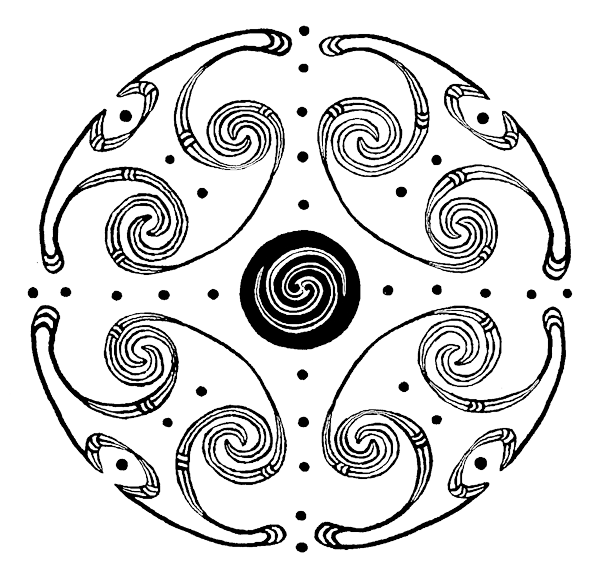
Urutengangana: Qualities of the first-born: guidance, safety, leadership
Jacqui Lees, Kaiwhakahaere/Team Leader at Pakuranga Baptist Kindergarten, reflects on strengthening the belonging and identity of refugee and immigrant children in their kindergarten.
Te Whāriki, our early childhood curriculum, talks about children having relationships with people, places and things, and this is what we have been thinking deeply about.
What is our children’s relationship with the local area, with the mountains, with the rivers and with the landscape close to kindy that we walk in each week?
Over the past year and a half, we have been working with Linda Mitchell from University of Waikato, on a Teaching and Learning Research Initiative (TLRI) focused on strengthening the belonging and identity of refugee and immigrant children.
Our research has been strongly impacted by our Enviroschools kaupapa and connected to our weekly walks around the estuary that runs behind our Kindergarten.
In Term 3, 2018 the teachers began talking with families about their places of origin and working on pepeha as a way of sharing stories about the places we came from. Originally our desire was to find out more about the cultural heritage of our immigrant families, but the teachers quickly realised that we were learning quite a bit about the local area as well!
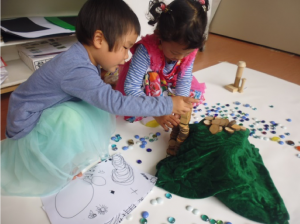
Children using 3D modelling.
As information came in from families about the mountains and rivers in their home countries, we looked them up with the children to find out about these places, and to talk about their personal experiences. Stone Mountain and Wu Yi in China were two mountains that we learned about.
From there our children began to talk about the maunga (mountains) in our local area – Maungarei and Ōhuiarangi.
Children drew their maunga and awa, they also learned pūrākau about their local maunga. Children were encouraged to predict what they might see on Maungarei using 3D modelling to help express this.
Before visiting Ōhuiarangi (Pigeon Mountain) students learned that everything has mauri (everything has a life force and is connected, and we should treat everything we encounter with respect) and our wairua is enhanced as we go to special places.
They wanted to experience a sense of Kotahitanga (unity), Manaakitanga (caring for each other) and Kaitiakitanga (caring for place) on their trip.
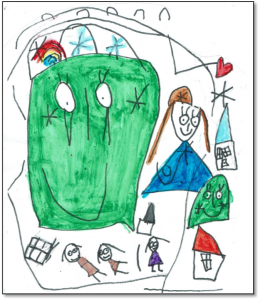
Summer’s picture showing the children rolling down the maunga features in their illustrated story book
Months of student-led work followed, and outcomes included two legacies, a mural of Ōhuiarangi and a beautifully created illustrated story written in collaboration with their students and then locally published.
The teachers feel that after a year and a half of connecting with the estuary behind the Kindergarten, both teachers and children are now beginning to know it better.
We see the seasonal changes, we look forward to the blossoming of the fruit trees, and also to the autumnal changes to the leaves of the London Plane trees and the joy of jumping in them as they fall in great piles in the park.
We have given significance to particular places that we love, Te Rakau Nui (the big tree) that we greet as we emerge from under the bridge, the house tree where we climb and play under, the bank under the monkey puzzle tree where we love to eat our snack, and the bank where we stop to throw stones into the creek. We have a relationship with all these places that we love to visit each week.
“We have had such an amazing time working on this, for us it is an example of how the Enviroschools Kaupapa really supports learning, and particularly early childhood learning. Enviroschools Rocks!” – Jacqui Lees
As the investigation comes to an end, the teachers look back at the fantastic learning there has been for our children over the past few terms. We believe that the children have –
- Developed their own working theories about their worlds – their families and their home countries, and also about Pakuranga the place that that they now call home
- Developed deeper understandings of the culture of Aotearoa/New Zealand
- Come to appreciate and enjoy experimenting with the traditional art form of kowhaiwhai
- Come to understand that they are each unique and have their own ways of understanding the world
- Developed an understanding that we are all different, and that this makes the world an interesting place
- Come to understand that we don’t have to agree about things, we can have different ideas and still be friends
- Made connections between people, place and things in their home countries and also here in New Zealand
- Developed rich understandings of mathematics in a meaningful way through their play
- Developed rich oral language and literacy skills
- Explored the arts, such as drawing, painting, dance, collage as tools to think through and represent their ideas
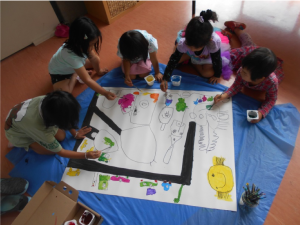
Together the children draw their houses, roads, cars, the sky tower and supermarket and their maunga
- Developed a deeper sense of their own mana atuatanga –their uniqueness and spiritual connectedness, as they explored and developed a relationship with the local maunga and awa
- Developed an understanding of themselves as active citizens in connection with the local mountains, who care about the ecology of these unique and special places and have become kaitiaki of them.
“I think some mountains have names but not all.I can see a sky tower beside the Mt. Wellington mountain. Yang Ming Shan is the mountain I know in Taiwan.” – Carina
“I went to Pigeon Mountain with my family before. We were looking at plants because we like plants and flowers.” – Chloe
“I have never been to Pigeon Mountain. I think mountains are for people to slide down into puddles.” – Nina
See the fully documentation of this inspiring story in the Enviroschools Team Area.
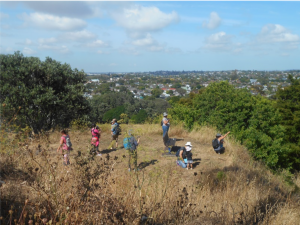
Visiting Maungarei.